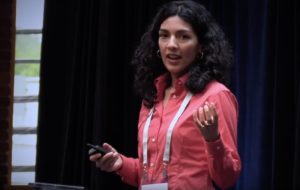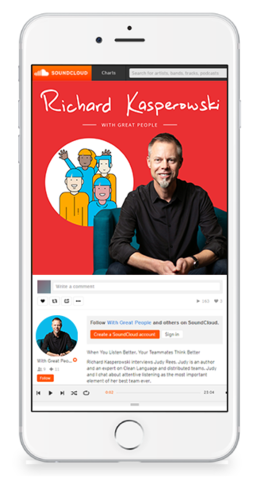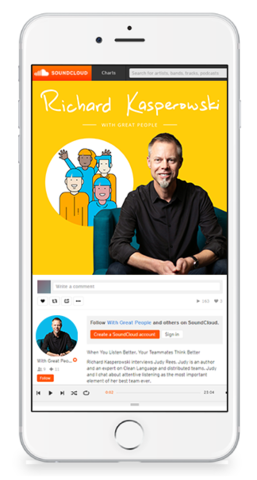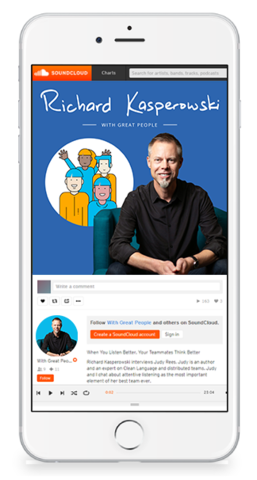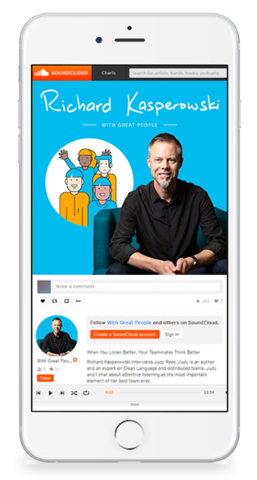Categories
Radhika Dutt: How to Create a Clear Vision for Your Company?
Richard interviews Radhika Dutt. Radhika is an entrepreneur, product leader, and co-founder of Radical Product Thinking. At Radical Product, it is all about vision-driven product creation. But how do you define the vision of your company, and how do you ensure that everybody follows it? Radhika gives us a few tips. When you finish listening to the episode, make sure to connect with Radhika on Twitter and LinkedIn.
Radhika Dutt: How to Create a Clear Vision for Your Company?
with Radhika Dutt
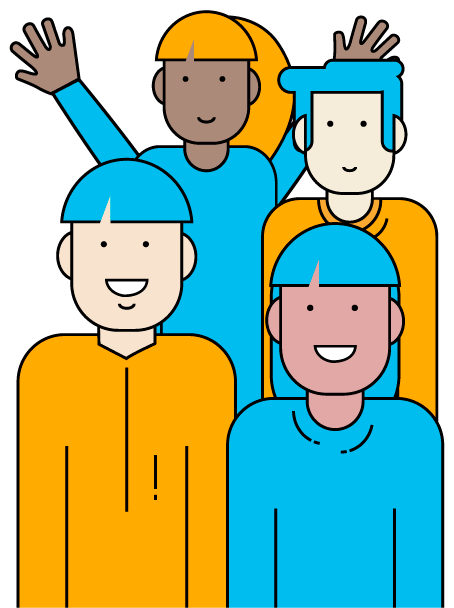
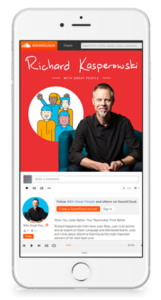
TRANSCRIPT
Richard 00:11
Hi friends, welcome back to With Great People, the podcast for high performance teams. I’m Richard Kasperowski.
Things have changed quite a bit in the United States, my home country, and around the world. The health crisis is practically all I think about. At times, I think my work, including producing this podcast, is completely irrelevant, it’s not helping anyone survive. I should be spending my time on something more valuable. It turns out, we recorded most of these podcast episodes many months ago, and we have a regular production rhythm to share them with you. I’ve decided to continue publishing the podcast because it’s important for us not just to survive, but to thrive. We need to continue staying connected, and sharing our best with each other. I’m hopeful that this podcast will help us thrive. I wish you good health, and I look forward to seeing you in our future world, free of this Coronavirus. And now, the original introduction to this episode.
In this episode, I talk with Radhika Dutt, an entrepreneur, product leader, and co-founder of Radical Product Thinking. Vision driven products is the core of Radical Product Thinking, but figuring out the vision of your company and your product takes a lot more than just scribbling a list of good wishes on your website. Radhika gives us a few tips on how to define your vision effectively.
To support this podcast, visit my website Kasperowski.com.
Richard 01:43
Our special guest today is Radhika Dutt. Hi Radhika, how are you?
Radhika 01:47
Hi Richard, thanks for having me. I’m good. How are you?
Richard 01:50
I’m fantastic. It’s my pleasure having you on the podcast, I’m so glad you could join us today.
Radhika 01:54
Likewise, I was looking forward to it.
Richard 01:55
Will you introduce yourself to our listeners?
Radhika 01:59
Great. I’m Radhika Dutt, and my background is that I’ve been an entrepreneur and a product leader, and I’ve built several products. What I do currently is I’ve been working with large organizations, and small, and I co-founded Radical Product Thinking as a movement, to feed as creating vision driven change. I’m also working on a book about Radical Product Thinking.
Richard 02:24
All right. You’re going to have to tell us more about Radical Product Thinking, and vision driven change. What’s that all about?
Radhika 02:31
Excellent. For that, I have to tell you a little bit about my story, which starts with I mentioned that I started companies, and built products.
Radhika 02:41
My first company was actually called Lobby 7, and was actually while I was still graduating from MIT. It was myself, and four other classmates, and we started Lobby 7. We did exactly what we all talk about doing in building products, which is iterate, try things. You see what works in the market. If one thing doesn’t work, you try more, and so on. That’s how we built our first product. What we ended up building, back in 2000, was an early version of Siri. That experience really taught me that iteration alone is not what we should be using to build products. While we did this back in 2000, where we kept iterating, and then finally we came up with a product, all the iterations that we had to go through in the meanwhile sucked up a lot of the funding. As a result, by the time we built this product, the Siri back in 2000, we ran out of our funding.
Radhika 03:50
The company did get bought out, it became what is now known as Nuance. Or, part of what is now known as Nuance. But, the lesson from Lobby 7 was there has to be a better way of building products. What was interesting, though, was every time we built products, or every time I was leading product teams, et cetera, or advising other startups, et cetera, and building products myself, there was the same pattern of product diseases that kept coming up. This was both in large companies and small. I’ve worked in so many different industries, from broadcast and telecom, to media and entertainment, ad tech, AI, even win. Yet, these same diseases keep coming up, in all these different industries.
Radhika 04:43
The question that it led me to was, is it that building good products is a matter of just an innate skill? You’ve either got it, or you don’t? Or, is this something that we can actually learn? That’s what led to Radical Product Thinking. There were two other people that I met along the way, Nidhi Aggarwal and Geordie Kaytes, and we, all three, had found the same set of product diseases, over and over. We said, “Let’s build a framework where we can really make it easy to apply product thinking.” That’s how Radical Product Thinking was born.
Radhika 05:19
It’s really a methodology for building these vision driven products, and it makes it very practical, because it’s a very step-by-step approach.
Richard 05:27
Okay. By vision driven products, what do you mean?
Radhika 05:30
Yeah, excellent question. I like to talk about products as being either radical products, or iterative products.
Radhika 05:38
Iterative products, that’s what we’re really familiar with. That’s where we build products by iteration. Trying one thing, that doesn’t work, trying another strategy, and so on. A radical product is where you’re fundamentally creating change, where you’re changing the nature of either user behavior, or doing a new way. Creating a product that’s altering the nature of something, that’s why it’s radical.
Radhika 06:04
To really illustrate what I mean by radical versus iterative, let’s take the example of Tesla Model 3 versus a Chevy Volt.
Richard 06:13
Mm-hmm (affirmative).
Radhika 06:13
Now, there’s a really famous auto expert, Sandy Monroe, who took apart these two cars. If you open up a Chevy Volt, under a hood, it turns out it actually looks very much like a gas car, except it happens to be electric. The Chevy Volt, if you focus on just one area, let’s pick the cooling system.
Radhika 06:36
This cooling system in a Chevy Volt, there are three different cooling systems. One’s for the engine, one is for the battery, and one is for the cabin. If you, let’s say, compare this to a Tesla Model 3, you open it up and it looks nothing like a traditional car. If you focus in on just the cooling system, you find that it’s one single system that does heating and cooling, for the entire car. They actually call this thing Superbottle, and they designed it ground up, from scratch. It’s an incredible piece of thought process.
Radhika 07:15
What was particularly astonishing for this auto expert was he was saying, “We’ve talked about this in Detroit, for a long time. But, the thing is, in Detroit each of these cooling systems, and components of these cooling systems would be somebody’s fiefdom.”
Richard 07:29
Oh yeah.
Radhika 07:30
So, when Tesla had to come up with this, they were not limited by silos in a company, it was figuring out how to do something, and fundamentally create change. A radical product like Tesla’s is also driven by a very different vision, compared to the Chevy Volt.
Radhika 07:48
If you compare the two visions, Chevy Volt’s vision was they wanted to beat Tesla Model 3 to market, with a range of over 200 miles. It was a vision that was about reacting, right?
Richard 08:00
Okay.
Radhika 08:01
If you look at Tesla Model 3’s vision, that was about making an affordable car that made it so that we were reducing our dependence on fossil fuels, without making it a compromise for the driver.
Richard 08:14
Right.
Radhika 08:15
These fundamentally different visions led to fundamentally different products. The result, basically, is that the Model 3 is a radical product, that Sandy Monroe says, “This is not inching up, it’s really a revolution.”
Radhika 08:30
The sales results show for it, right? It’s been outselling the Mercedes Class C, BWM 3 Series, and the Audi A4, all of those combined. The Chevy Volt, by the way, it’s not a bad car, actually it’s a nice little car, it’s just not revolutionary.
Radhika 08:46
That’s the question that we have to ask ourselves, what we’re building in our teams. Do we want to build iterations of status quo? Which, by the way, may be okay in certain cases, if you have an established product and you’re growing it, et cetera, maybe you’re just building an iteration. Or, maybe you need to think about building radical products, and that’s really what Radical Product Thinking is about. How do you build these radical products?
Richard 09:08
All right, thanks. Now, this is the podcast about teams, and the best teams that you’ve ever experienced in your life. Is there one of those for you? Or, which one of those is yours? What’s the best team of your life?
Radhika 09:20
I think there are two teams that I have found absolutely amazing.
Radhika 09:24
One that I’ll focus on was the one that was counterintuitive, I didn’t expect this to be the best team. Let me tell you why I didn’t expect it to be the best team.
Richard 09:36
All right.
Radhika 09:38
The management, actually, did not have a clear vision for what we were doing, where we are going. Within the team itself, it was almost like the sense of okay, we as a team … It was almost like us against them. Us in the team, versus the management. That, you never expect that in a good team. The second thing is we were outsourcing some of our engineering. Some of our engineers were local, and the rest were based out of India. The third thing is that the entire team was actually very new to Agile. They had only just started being agile, a few months before I joined.
Radhika 10:18
Despite these three things, it turned out to be absolutely one of the best teams. To the point where, even though we’ve all dispersed after years, we do reunions together.
Richard 10:29
Wow.
Radhika 10:29
We go do our thing that we used to do, when we were working together. It’s something that continues today.
Richard 10:37
All right. Now, if you could take yourself back to this team, it sounds like sometimes you do, you have these reunions … if we could go back to this team right now, take a mental journey, a spiritual journey back to this group of people and the work you were doing together, and if we could reexperience that work, and being together with that group, and really relive it, is there one word that you could use to describe the sensation of what it feels like to be together with that group?
Radhika 11:05
I think the one word that springs to mind is cohesive.
Richard 11:07
Cohesive?
Radhika 11:08
It just felt really cohesive, we just gelled well together. That’s the thing about this team, that I never remember it feeling confrontational. It’s not to say we didn’t have good discussions, but it never felt adversarial, ever.
Radhika 11:26
If I look back, there were a few things about this team that was incredibly different. I said why it was unlikely that this would be a good team, when I walked in, the management didn’t have a clear vision. How do you have such a cohesive team, when that management team didn’t have that vision?
Richard 11:44
Right.
Radhika 11:44
What was interesting was that we, then, built a really clear vision for what our product was going to do. Regardless of whether the whole company, and the management team had a vision, we had a really clear vision for the product. We knew exactly whose world we were trying to change, and what we wanted their world to look like, and we were driven by this vision.
Radhika 12:09
It was cohesive as a team because it wasn’t like, as the product leader, I was telling the team, “We should do this,” and everyone else just followed. It was truly one of those things where we shared this vision for what we wanted to do for our users. To the point where, after we had watched user testing, and everyone had this shared understanding of the user, there were occasions where I had written up the user story, and the engineer actually came to me and said, “I read your user story, and it sounds like you’re saying this, but I really think you want this. Is this what you want?”
Radhika 12:53
I was like, “Yes, you’re exactly right. My mistake, let me go correct that user story, that’s really what I’m looking for.” That’s the kind of working, cohesive team where you’re really feeling like you’ll understand the user.
Radhika 13:12
There can be mistakes in requirements, right? It wasn’t about following requirements. It was that every one of us was driven by this shared vision.
Richard 13:20
All right. Okay, this shared vision, I can hear it in your voice, too, and see it. I have the privilege of being able to see your face as we talk, and our listeners don’t have that privilege, so I get to see all the passion and happiness, as you’re talking about this team, and the shared vision you had together. Even that little story, about the engineer helping you adjust the user story, that was a happy story, you had a big smile as you were telling it.
Richard 13:46
What else, subjectively, about this team … subjectively, or objectively, what are things that went into it, that go into this feeling, of this really was the best team?
Radhika 13:59
Yeah. I think one other thing about this team was they were all incredibly capable people, and it was a very diverse team.
Radhika 14:05
This was, by the way, the first time I was working with an engineering team where more than half the team were actually women, and it really felt like every voice was being heard. The engineering manager was someone where, I was talking to one of his engineers, and she was saying to me, “I would follow him to the ends of the Earth.” This was exactly the kind of loyalty that everyone felt, within this team.
Radhika 14:34
It was interesting. Even though we felt this way about the management, this team, we all stayed together for much longer than I would have ever expected. We were all together for two to three years, before people started dispersing. When I describe the company in this way, you would think everyone would have dispersed very quickly, but this is the kind of environment that kept us all together.
Radhika 14:56
What’s really interesting that I think back to, by the way, is I talk about this shared vision, it makes it seem like we were really changing the world, doing something big. What’s interesting is that this was actually a product related to advertising, and it wasn’t that we were changing anyone’s world significantly, we were actually being very focused on privacy safe approaches, et cetera. But, that said, it wasn’t a vision that you would say, “Oh my goodness, that sounds so inspiring. Of course, you guys are all together.”
Radhika 15:30
It was one of those things where, genuinely, it was because … By the way, this was my realization that a vision doesn’t necessarily have to be big or change the world, it has to be shared. That’s really what this team had. To answer your question, what’s the other subjective quality, that it was a very diverse team, that had this shared vision. It didn’t matter whether the vision was big or small, it was just that we really all cared about it.
Richard 16:02
I love the way you say it, “the vision doesn’t have to be big or change the world, but it does have to be shared.”
Radhika 16:07
Right, exactly.
Richard 16:09
If I had been there as a fly on the wall, watching the team, watching you all do your work together, what are some concrete behaviors I would have noticed?
Radhika 16:16
Excellent question. I did mention a diverse team, but [inaudible 00:16:20] it felt really inclusive. It was never, ever adversarial. That’s, I think, a really important part.
Radhika 16:26
I think one of the frequent things portrayed in the media about teams that are driven, and achieving something is that you have to be abrupt, and really pushy or confrontational, you call each other out. This was all really very gentle, and our talks were always very friendly and professional. We were assertive, but there was never, ever any sort of yelling, or aggressive behavior towards one another. That was, I think, a really important piece.
Radhika 17:00
The other was there was never any blame culture. If things went wrong, it really didn’t matter whose fault it was, who did what. We never even asked that question, what did we do, it was always from the perspective of what do we do differently next time? That was also really nice, because it felt like it was really safe space, to both try things, and then see if something did work well, we learned from that.
Richard 17:30
All right. How about advice for listeners, how could they replicate some of this team’s greatness?
Radhika 17:40
The thing about the vision is, by the way, the one thing that I see that keeps coming up, across different teams. When I find that teams are not aligned on decisions, it’s for one of two reasons. Most often, by the way, it’s because they’re not aligned on their vision. It happens so often that we think we have a clear vision, because the company has a vision statement, but almost always that vision statement ends up being very broad.
Radhika 18:10
For listeners, here’s the first test I’d ask you to try. If you take this vision, is it so broad that it’s not acting like a compass? Meaning, you should be able to think of a feature in your head, and then compare it to this vision and say, “Does this match the company’s vision?” It should actually filter out some features. Let me give you an example.
Radhika 18:35
There is a real company in this world that has this vision, and the vision is “contributing to human progress by empowering people to express themselves.” I’ll give you a moment to meditate on that. It’s really a very, very broad vision.
Richard 18:53
Yes.
Radhika 18:53
This thing, though, “empowering people to express themselves.” Now, I can think of so many companies or organizations that have this vision. A non-profit that I was working with that was doing public art, that was empowering people to express themselves. A company that was helping whistle blowers have difficult conversations in their organizations, they were helping people express themselves. The list can go on and on, right?
Richard 19:19
Right. This shirt I’m wearing is a way of expressing myself.
Radhika 19:24
Precisely. Want to take a guess as to which company’s vision this one is?
Richard 19:29
Oh my God. No, it really is so broad, it could be any company.
Radhika 19:34
Okay, so it’s Snapchat’s vision.
Richard 19:35
Snapchat? Interesting. Okay.
Radhika 19:37
That’s exactly the reaction most people have.
Richard 19:41
Well, they could do anything, they could be in the business of t-shirt printing, or public art production, or anything.
Radhika 19:47
Right, exactly. That, in itself, is very often the start of a product disease I like to call strategic swelling, where your product starts out doing one thing, and then it slowly just bloats until you no longer recognize it. We all have seen products that do that.
Radhika 20:05
Going back to the test. If you’re a listener, look at your vision and see is it broad where a lot of different companies can be described by this? Or, a lot of different features would pass through this filter, even though you really don’t think that you should be doing this, right?
Richard 20:20
Right.
Radhika 20:20
In that case, it really is too broad of a vision. What you need is a detailed vision that’s really actionable.
Radhika 20:26
When we built Radical Product Thinking … by the way, it’s a movement, and it’s all free. This is not a consulting organization, just to put it out there. You can freely download the toolkit. Part of the toolkit, the first thing is how do you build a good vision, that’s detailed enough? I call it the source code of your vision.
Radhika 20:46
The source code, basically, it helps you answer some questions in a fill-in-the-blanks format, so that you can do this as a group exercise. That’s really where you can build this alignment with your team, by doing this as a group exercise. It helps you air your differences on where we’re really not aligned. That’s something I highly recommend, for every product team, to just sit down and do this exercise, no matter how much you think your company has a clear vision.
Richard 21:16
All right. This is really important. Where can we download this, where can we read this?
Radhika 21:21
It’s on RadicalProduct.com.
Richard 21:23
Okay. RadicalProduct.com?
Radhika 21:26
Yes. You can find it-
Richard 21:28
Excellent. I want to read this. My big question was yes, I believe you, shared vision is the thing, how do I do it? So, we’ve got a toolkit, for helping us get there?
Radhika 21:39
Right, exactly. My experience with creating a vision was, very often, you sit in these group exercises, and it’s a four hour, or a whole day event, offsite thing. It’s just really not very productive, honestly. I’ve done lots of surveys and people always say these meetings, at the end of the session, you never come out with a vision that’s radically different from what you had started with. That’s what we wanted to change, with the Radical Product toolkit. We really wanted it to be a productive session.
Radhika 22:15
We’ve designed the toolkit such that, at the end of an hour, you’re actually done with your visioning. At the most my visioning sessions have ever taken have been an hour and a half.
Richard 22:27
This sounds awesome, I am definitely going to check this out. This is really awesome, this is stuff that I really want, and I want to be able to share with people.
Richard 22:33
Any other advice for listeners, or anything else that you want to add?
Radhika 22:37
One other thing is that, in my second startup, and this is the mistake that I made, we had a clear vision and, yet what we thought was the right way to build products was that you start with a clear vision, but then you iterate, to try different things as part of building your product.
Radhika 22:57
One of the things that I’ve seen us do repeatedly in organizations is in using Lean and Agile, we work very hard in making sure we are iterating fast. We work hard on optimizing all of our processes, so that we’re able to iterate fast. What we don’t question is can we iterate less? That’s the piece that I want us to think about.
Radhika 23:25
What happens is, going back to product teams, when you iterate a lot, we each iteration that is a miss, you lose a little bit of momentum.
Richard 23:38
Sure.
Radhika 23:38
As you lose some of this momentum, it chips away at how fast you’re making progress, and just how cohesive the team is, et cetera. The big learning for me, from my second startup was having a good vision is very important, but the next step after that is that you have to translate that vision into a strategy. Your strategy has to be what you then translate into priorities, and then into execution and measurement.
Radhika 24:10
Meaning that your entire product development approach, it should be driven by this vision and strategy, and the iteration is the last part. It’s how you actually test your vision and strategy in the market, and then you make progressive changes. But, it’s so important to really start out with not just the vision, but also have a clear strategy. That’s part of what we defined in Radical Product Thinking, as well.
Richard 24:36
All right. We’ve got the website, RadicalProduct.com. How else can listeners get in touch with you?
Radhika 24:43
Yeah. I actually really like to have conversations with people, and understand how they’re building radical products. Especially because I’m working on the book, I love hearing people’s stories of how they’re building radical products. Yes, the best way to reach me is through LinkedIn, and the second is through Twitter. But, I’m a lot more responsive on LinkedIn.
Richard 25:05
All right, we’ll put links to those in the episode description. Radhika Dutt, thank you so much for being with us today. I really enjoyed this conversation, thanks.
Radhika 25:15
Thank you so much. Likewise, I really enjoyed it.
Richard 25:22
Hi friends, thanks for listening. And remember, to support this podcast, sign up for my newsletter at Kasperowski.com.
